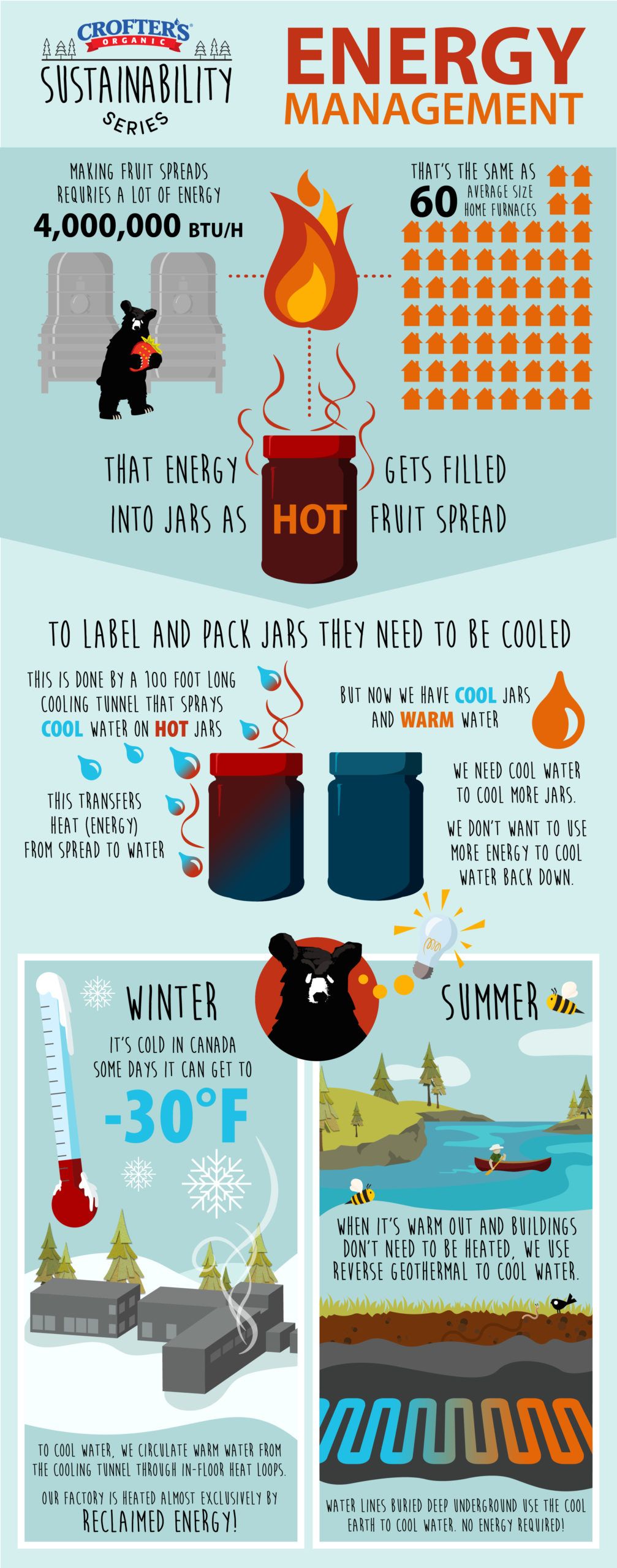Energy Management | Sustainable Spread School
Being Eco-Friendly is Our Jam!
Here is How We Manage our Energy
Fruit spread making calls for a lot of energy for both heating and cooling, see how our approach to energy management is a cut above! It’s no secret that manufacturing plants use tons of energy. Energy is key making any product and is vital for production. The manufacturing sector accounts for nearly 33% of all the energy consumed. Now, that’s a lot of energy! Fruit spreads, in particular, require significant energy inputs due to being fairly dense. The denser the product, the more energy it will take to heat/cool.
One of the key food safety processes in producing our spreads is “pasteurization”. By heating our products to a minimum of 87°C (189°F), we can ensure to destroy any potential pathogens, ensuring that nothing but sweet, fruity goodness makes it to your toast! However, to achieve this requires roughly 4,000,000 BTU/hour of energy input! That’s the equivalent of about 60 home heating furnaces! Unfortunately, there is no way around this. The product must be heated and energy is the only way to do it. But, it’s what we do with this energy after the jars have been filled that is really unique! Stick with us here, things are about to get a little heavy, but you can do it!
Alright Brainiacs, Time to Put on Your Physics Thinking Cap!
The first law of thermodynamics states that the total energy of a closed system remains constant. That’s to say, once the energy is imparted, it does not disappear, it can only be transferred from one body to another. So, after we fill our glass jars with piping-hot fruit spread, the energy which we imparted as heat in the cooking process remains. Because we need to cool the jars down quickly to label and package, they pass through a cooling tunnel which is over 100 feet long! In the tunnel, cool water sprays the jars to reduce the temperature of the glass in preparation for labeling. But this is where the ingenuity begins…

Remember What We Said About Conservation of Energy?
Well, most of the energy, previously held by the jar of jam, is now transferred to the cooling water, significantly raising its temperature. This, again, raises a problem, as we need the water to be cool to cool off more jars of spread! You can see how this cycle can become extremely wasteful. In conventional operations, the now warmed water would pass through refrigerating equipment (which requires energy to run) to cool it back to a useable temperature. This was just an option we were not going to consider.
To cool the water, we have two unique systems, which we use depending on the season.
In the winter months, it gets cold in our Northern community. We mean REALLY cold, as cold as -30°F. Obviously, this requires us to heat our buildings significantly. So, instead of using MORE ENERGY to heat, we installed in-floor heating loops that run through our entire production facility. When the warm water from the cooling tunnel passes through these loops, the energy (heat) is transferred through the floors and into the surrounding environment, eliminating the need to heat the building almost entirely!
In the summer, when its not inhumanely cold outside, we have a different way to cool our precious water. Buried deep under the property which our facility sits on are hundreds of feet of tubing. These tubes act as a geothermal cooling mechanism, using the cool temperature of the earths soil to reduce the temperature of the water. Although the energy from the warm water has now been lost, we at least do not require additional energy to reduce the temperature of the water through refrigeration.
Wow, thanks for making it this far, we know that was a bit dense, nice work!! In conclusion, we weren’t joking about being a cut about in our approach to energy management!
As a family-operated company, we enjoy holding ourselves to higher standards than the industry average! Curious about our family-owned roots, check out Our Story to learn more.


 Premium
Premium
 Just Fruit
Just Fruit
 Squeeze-able
Squeeze-able